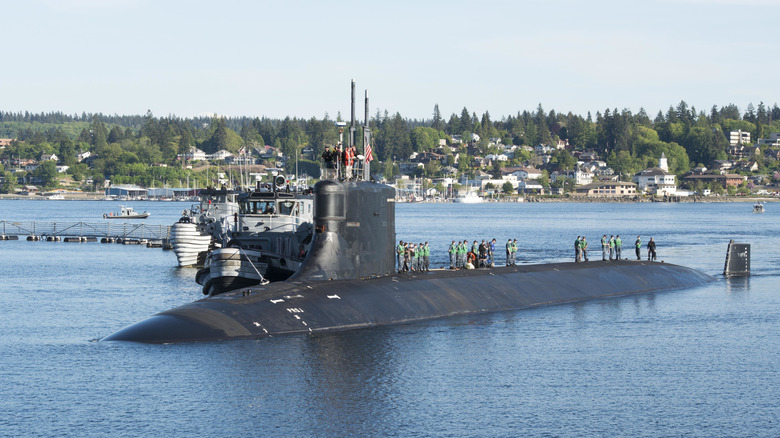Prior to the development of the “Block-V” Virginia-class submarine, the newest class of attack submarine in the United States Navy was the Seawolf-class. These were built after the Cold War with the first one being commissioned in 1997. They were undoubtedly more advanced than the Los Angeles-class attack submarines of the time, which is partly the cause for such an inflated price tag for them. Seawolf boats were expected to be the most expensive class ever built with 12 of them costing around $34 billion. Which is only part of the problem with one crashing into a seamount.
Advertisement
With only three state-of-the-art attack subs in the US Navy’s monstrous fleet, the Navy needed a new class to eventually take over when the older boats had to retire. In 2004, the Navy commissioned the USS Virginia, the first in a new class of fast attack subs built to replace the fleet of aging Los Angeles-class subs. Of the 53 nuclear-powered attack submarines currently active, 22 of them are Virginia-class. Even looking only at the Virginia-class’s control system, which is a fly-by-wire system, it is clearly superior to the older Los Angeles-class. Beyond that, the newest class offers intelligence-gathering abilities that the older class can’t remotely accomplish. But what about the Seawolf-class? How much more advanced is the new slate of submarines compared to the smaller fleet of Seawolf-class submarines?
Advertisement
Seawolf submarines are advanced but there are only three
The 353-foot Seawolf-class–unless it’s the USS Jimmy Carter, which is 453-feet long– can travel as fast as 25 knots underwater. It has a single Westinghouse S6W nuclear reactor that drives two steam turbines and produces 52,000 shaft horsepower. General Dynamics boasts that this submarine class is “Less detectable at high speed than a Los Angeles-class submarine sitting at pier side.” This likely makes them especially intimidating for adversarial vessels. That level of stealth doesn’t just enable the submarine class to sneak up on enemy subs, it can also gain them access to contested areas where they can deploy special forces divers to get behind enemy lines.
Advertisement
They’re not only sneaky, they also possess torpedoes on top of cruise missiles in their armament. General Dynamics built the Seawolf submarines to perform a wide variety of missions, including surveillance, intelligence collection, special warfare, cruise missile strike, mine warfare, and anti-submarine and anti-surface ship warfare. The Navy commissioned the first Seawolf-class sub, USS Seawolf (SSN-21), in 1997 while the last of the three, USS Jimmy Carter (SSN-23), earned its commission in 2005. There might only be three Seawolf submarines, but it’s not because they weren’t worth the money. Quite the opposite, in fact.
General Dynamics stopped at three Seawolf subs, despite the original vision being 29, because the Navy found it too expensive and there was no more Soviet Union. The Seawolf program started to gain superiority over Soviet ballistic missile submarines. Without the USSR around, those funds could go elsewhere.
Advertisement
Virginia-class subs are the newest
The Virginia-class submarine is the US Navy’s newest class of submarine, gradually replacing the Los Angeles-class subs as they retire. There are a great many advancements the Virginia-class has over most older submarine classes, including no periscope and a modular design that will allow it to continually be modified throughout its lifetime, keeping up with modern technology. Rather than use a traditional periscope for the Virginia subs, General Dynamic went with “two photonics masts that host visible and infrared digital cameras atop telescoping arms,” according to the Navy. This change might seem small, but it meant the control room could be placed farther away from the sub’s curvature, giving it a larger layout than its predecessors.
Advertisement
They’re only 377-feet in length with a diameter of 34-feet, displacing 7,700 tons of water when submerged. Like the Seawolf boats, this class is rated to go roughly 25 knots at full speed and travel as deep 800 feet. Its weaponry is possibly one of the more enticing aspects for submariners as it can be armed with Mark 48 advanced torpedoes, Tomahawk cruise missiles, Mark 60 CAPTOR mines, and advanced mobile mines.
How the Seawolf and Virginia-class attack subs are different from each other
Both classes of attack submarines can travel over 25 knots underwater and dive to a depth of roughly 800 feet but, according to The National Interest, there are sailors who claim that the Seawolf boats are faster and can dive deeper. They’re also arguably stealthier because of their pump-jet propulsor system that produces thrust via a ducted propellor. Well, that might have been the case before the Block V sub made it out to sea. The Virgina-class subs use anechoic coating on the hull, reducing its overall acoustic signature by absorbing and scattering sonar signals.
Advertisement
It’s not the mere fact that Virginia subs are newer that gives them an edge over other classes. While current Virginia-class subs are performing their duty, the Navy gets to see their strengths and weaknesses, allowing them to commission small adjustments to those still under construction. Making subtle adjustments to each new batch of subs like the anechoic coating gives them more versatility. Since there aren’t any more than three Seawolf boats, they can’t undergo such extensive modifications at a steady rate. General Dynamics made three and that was it.
Additionally, the Virginia-class has 76% more firepower than other submarines in the US Navy’s fleet. Then there’s the matter of a vertical launch system (VLS), which the Seawolf-class has none to speak of. This isn’t necessarily a drawback since it can still fire anti-surface cruise missiles via torpedo launchers, but having both torpedo tubes and a VLS definitely adds to the Virginia-class’s versatility.
Advertisement

